A Form Task represents an activity that a participant performs as part of a case within ProcessMaker Platform. It serves as an interactive step where users provide input or make decisions using screens built in the Screens Builder. A Form Task can be assigned to:
A specific user
A member of a group
The previous task assignee in that case
The user who started the case
Add a Form Task to a Process
Permissions
Your user account or group membership must have the following permissions to configure a Form Task object in the Process model unless your user account has the Make this user a Super Admin setting selected:
Processes: Edit Processes
Processes: View Processes
See the Process permissions or ask your Administrator for assistance.
Add a Form Task object from one of the following locations in the Process Modeler:
Object Panel: Located to the left of the Modeler, the Object Panel contains various process modeling objects.
Object Bar: Located at the bottom of the Modeler, the Object Bar contains pinned modeling objects for quick access.
Follow these steps to add a Form Task object from the Object panel to the Process model:
Ensure that the Object panel is visible. If not, click the Add icon
.png) from the Object bar at the bottom.
from the Object bar at the bottom.Click the Task object
.png) from the Object panel to select it.
from the Object panel to select it. Click the location in the Process model to place this object. Follow these guidelines when placing this object:
If there is a Pool object in your process, the Form Task object cannot be placed outside of the Pool object.
To place this object between two existing objects, follow these instructions.
.png)
Follow these steps to add a Form Task object from the Object bar to the Process model:
Ensure that the object is pinned to the Object bar. If not, see instructions to pin it.
In the Object bar at the bottom center, click the object's icon.
Click the location in the Process model to place this object. Follow these guidelines when placing this object:
If your process has a Pool object, the Form Task object cannot be placed outside of the Pool object.
To place this object between two existing objects, follow these instructions.
.png)
Add boundary events
- Boundary Timer Event element
- Boundary Error Event element
- Boundary Signal Event element
- Boundary Conditional Event element
- Boundary Message Event element
Replace a Form Task with a Different Task
After a Form Task is added to a process, you may replace it with a different Task type or a Sub Process. Follow these steps to replace a Form Task with a different task:
Select the Form task to change to another object.
Click the Objects icon to view a list of task types.
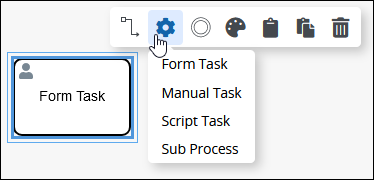
Select the object to replace the Form Task. The Change Type screen displays to confirm replacing the currently selected object.
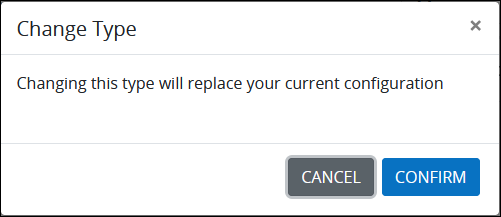
Click Confirm. The new object replaces the Form Task object with its default settings and color.
Settings
The Form Task object has the following configuration settings:
Properties Panel Settings
The Form Task object has the following settings in the Properties panel:
Edit the Object Name
An object name is a human-readable reference for a Process object. Process Modeler automatically assigns the name of a Process object with its object type. However, an object's name can be changed.
Follow these steps to edit the name for a Form Task object:
Select the Form Task object from the Process model in which to edit its name.
Ensure that the Configuration panel displays. If not, show it. The Name setting displays. This is a required setting.
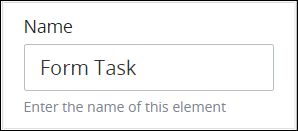
In the Name setting, edit the selected object's name and then press Enter.
Select a Screen for the Task
Since Form Tasks are designed to collect or display Request information, a screen must be associated with them. Follow these steps to select a Screen for a Form Task object:
Select the Form Task object from the Process model.
Click the
.png) icon to view the Configuration panel.
icon to view the Configuration panel.Expand the Configuration panel if it is not presently expanded, and then locate the Screen For Input setting. This is a required setting.
.png)
Do one of the following:
From the Screen For Input drop-down menu, select one of the available screens.
To create a new Screen, click the Create a new screen link. A new browser window opens to create a new Screen. After the Screen is created, it is automatically linked to the Form Task.
Optionally, click the Open Screen link to view and/or edit your Screen. Note that your user account must have appropriate Screen category permissions or be a Project member in which this Screen is an asset.
Ensure to select a Screen for each Form Task in your Process model. If a Screen is not specified and Requests are started for that Process, the following message will be displayed.
The placeholder Screen allows the Task assignee to continue the Request without causing it to pause indefinitely.
If no Screens exist, the Screen For Input drop-down menu contains no options.
Preview the Screen for a Task
After selecting Screen for the Task, you may preview the associated Screen, which allows you to interact with and verify the Screen content in the same Process Modeler.
Follow these steps to preview the associated Form Screen from a Form Task object:
Select the Form Task object to preview the associated Screen. Available options display above the selected object.
Click the Preview icon
 . A preview window displays on the right-side of the Process Modeler.
. A preview window displays on the right-side of the Process Modeler. 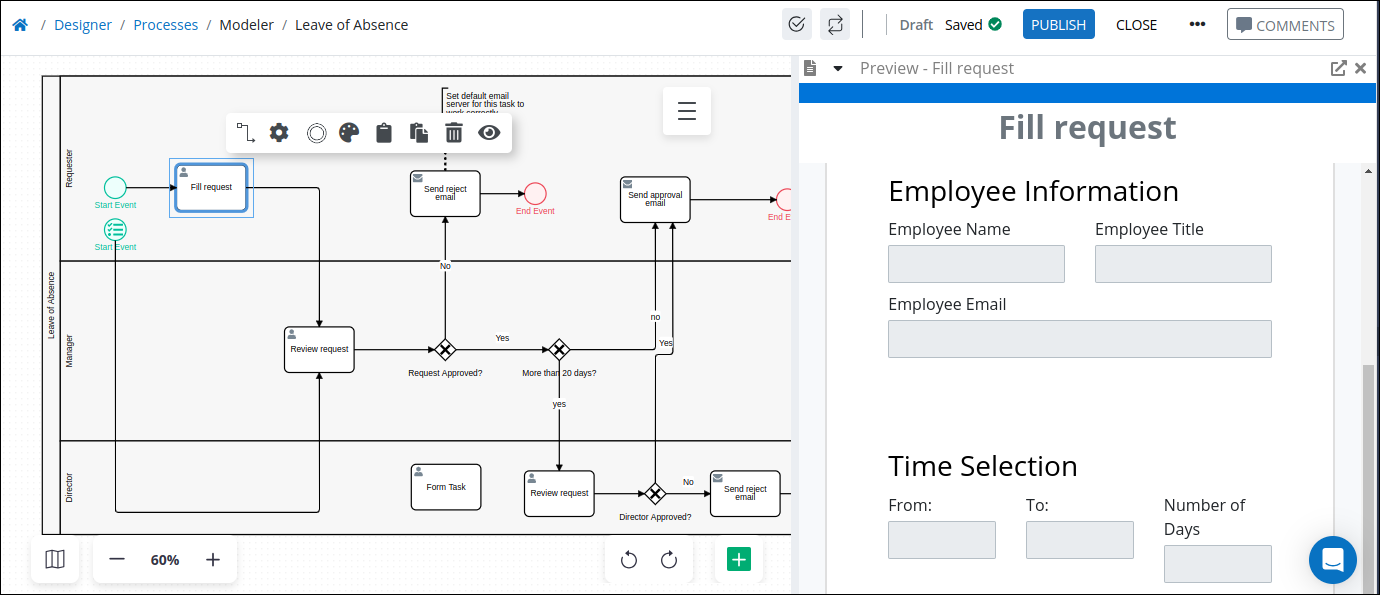
Previewing the Screen for a Form Task object
In the Preview window, you can do the following:
Click the icon
 to open the Screen Builder to edit the Screen.
to open the Screen Builder to edit the Screen.Click the icon
 to close the preview window.
to close the preview window.Click another Task or connector object to change the asset in the same preview window.
The following message displays if you try to preview a task with no associated screens.
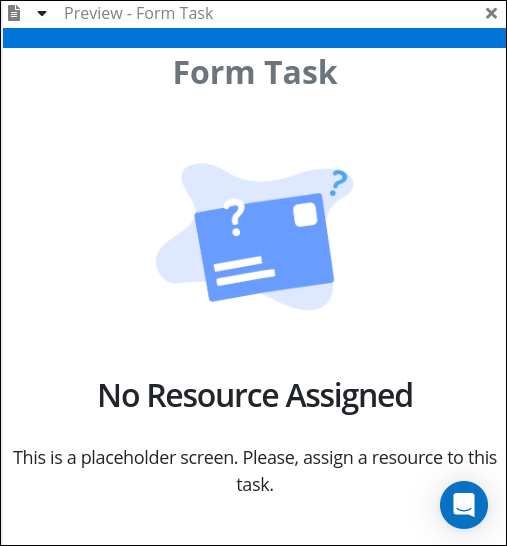
Select the Task Destination
Specify the destination to which users are redirected after completing a task. By default, users return to their original access point, such as a task list, dashboard, or previous page. You can override this behavior to redirect users to locations such as the process LaunchPad, a specific dashboard, or an external URL.
Follow these steps to select a object destination:
Select the Form Task object from the Process model.
Click the
 icon to view the Configuration panel.
icon to view the Configuration panel.From the Task Destination drop-down menu, select the page to display after a user completes this task.
.png)
Select one of the the following options. Selecting a destination object other than Task Source will render the Display Next Assigned Task to the Task Assignee feature unusable since the object will have an alternate destination.
Task Source (Default): This option redirects the user to the original access point where the task started.
Task List: This option redirects the user to the Task list.
Process Launchpad: This option redirects the user to the Process Launchpad.
Welcome Screen: This option redirects the user to the Participant Welcome Screen.
Custom Dashboard: This option redirects the user to a dashboard. After selecting Custom Dashboard, a dropdown menu appears below to select the desired dashboard.
.png)
External URL: This option redirects the user to an external URL. After selecting External URL, a dropdown menu appears below to enter the URL.
.png)
Display Next Assigned Task
Use the Display the Next Assigned Task option to automatically take the user to the next task if it is assigned to them. If the next task is assigned to a different user, then the To Do Tasks page displays after Task completion.
Select the Display the Next Assigned Task option.
From the Screen Interstitial setting, select the Screen to display after this Task completes and before the next Task begins.
.png)
Benefits of Using Interstitial ScreensSmooth Task Transitions: Display a loading screen (e.g., "Loading your next Task") while a request routes to the next form-based Task.
Prevent Abrupt Endings: If a script task is followed by an end event, show a summary screen instead of abruptly ending the request.
Note:
Task Destination setting applies whether the user is completing the task while logged into ProcessMaker or as an anonymous user through a web entry.
If an Interstitial Screen follows a Web Entry Start Event in a child request, it cannot redirect back to the parent request—only to tasks within the child request.
Specify When the Task is Due
Configure when a task becomes due after it is assigned to a user. When set, the due date/time is displayed in the task list for each in-progress task. If a task becomes overdue, the task assignee is notified through an indicator in the task list.
Due dates can be set as a static number of hours during process design, or made dynamic by using variables in {{mustache_syntax}} for greater flexibility.
The task due date does not change in the following circumstances:
Task is reassigned to another user: The original due time remains the same and now applies to the new assignee.
An interrupting boundary-type event triggers: The event has its own due date, leaving the original task's due date unaffected. When an interrupting boundary-type event triggers, the workflow will route through the event, and the due date for any subsequent task will apply.
The default due time for a Form Task is 72 hours (three days).
Specify the due time as total hours, including non-business hours, overnight, weekends, and holidays.
A Self Service Task can become overdue even without an assignee. The due time starts when the task becomes active.
Follow these steps to specify when a Task is due:
Select the Form Task object from the Process model.
Click the
.png) icon to view the Configuration panel.
icon to view the Configuration panel.Expand the Properties panel, and then locate the Due In setting.
.png)
In the Due In setting, specify the total number of hours after which a task becomes due.
Enter the number of hours in the Due In setting and then press Enter.
Hover your cursor over the Due In setting, and then use the spin arrows to increase or decrease the total number of hours.
Select the Use Request Variable option and reference a request variable in mustache syntax
{{variable_name}}..png)
During a case, a numerical value must be assigned to this variable, indicating the number of hours after which the task will become overdue. For example, a value of
48will mark the task as overdue after 2 days.
Add a Placeholder for the Slideshow Mode
The Slideshow Mode makes it easy for process designers to share the design of a process with all stakeholders, regardless of whether they have access to the ProcessMaker Platform. For more information on how to create slideshows for a process, see Slideshow Mode.
Follow these steps to add a placeholder image for the Slideshow Mode:
Select the Form Task object from the Process model.
Click the
.png) icon to view the Configuration panel.
icon to view the Configuration panel.From the Placeholder for Slideshow section, click on the +Drag or click here button to upload an image.
.png)
A preview of the image will display, and the configuration will be auto-saved.
.png)
The uploaded image will be shown for this task the next time the slideshow is viewed.
Notes:
Size of a placeholder image for slideshows must less than 2 MB.
Image files with PNG, JPG, JPEG, and GIF extensions are supported.
Loop Characteristics Panel Settings
Use the Loop Activity panel settings to specify how to perform multiple instances of this object. The following loop modes are available:
No Loop Mode
Select the No Loop Mode option to perform this object's Task only once.
Follow these steps to specify characteristics to perform multiple instances of the Task:
Select the Task from the Process model. Panels to configure this object display.
Expand the Loop Activity panel. By default, the Loop Mode setting is set to No Loop Mode and the function is performed only once.
.png)
Loop
Select the Loop option to sequentially repeat this Task's function multiple times until an exit condition is True. This is useful when a function should be performed multiple times with the same set of data, such as, processing a credit card payment. This loop mode has the following characteristics:
The Task's function is repeated until the exit condition is
Trueor the maximum iterations limit is reached.At any given time, only one instance of the Task is active. The subsequent instance does not begin until the current instance completes.
The same exit condition evaluates at the end of each instance; however, value(s) of the Request variable(s) used in the exit condition can change during an instance resulting in the exit condition to eventually evaluate as
True.If any one instance of that function does not complete, workflow pauses.
All active instances are terminated if an interrupting boundary-type event object triggers.
 An object configured in this mode shows the Loop icon in Process Modeler.
An object configured in this mode shows the Loop icon in Process Modeler.
Follow these steps to specify characteristics to perform multiple instances of the Task:
Select the Task from the Process model in which to specify multiple instance characteristics. Panels to configure this object display.
Expand the Loop Activity panel to display the Loop Mode Setting.
From the Loop Mode setting, select the Loop option. The settings for this loop mode display:
.png)
In the Maximum Iterations setting, enter an integer value representing the maximum number of times this Task should be performed.
In the Exit Condition setting, enter a condition in FEEL syntax. When this condition is True the loop activity is halted.
Multi-instance (Parallel)
Select the Multi-instance (Parallel) option to perform this Task's Task multiple times in parallel a fixed number of times. This is useful when performing any action in bulk, such as sending an email to several people. This loop mode has the following characteristics:
Instances of the Task are governed by the size of an array-type Request variable where a new instance is created for each item in this variable. For example, an array with 10 items will create 10 parallel instances of this function that each contains data from its respective array index.
All instances begin simultaneously when this Task triggers; however, they perform their function independently of each other.
The function as a whole completes when all instances are complete.
The output from each instance can either be saved in the source Request variable or a new array-type Request variable.
All active instances terminate if an interrupting boundary-type event object triggers.
A Task configured in this mode shows the Multi-instance (Parallel) icon
 in Process Modeler.
in Process Modeler.
Follow these steps to specify characteristics to perform multiple instances of the Task:
Select the Task from the Process model in which to specify multiple instance characteristics. Panels to configure this object display.
Expand the Loop Activity panel to display the Loop Mode Setting.
From the Loop Mode setting, select the Multi-instance (Parallel) option. The settings for this loop mode display:
.png)
In the Request Variable Array setting, enter the name of an array-type Request variable. The size of this array will determine how many times this loop iterates.
In the Output Data Variable setting, enter the name of an array-type Request variable in which to store the results of all instances. Each instance of the loop saves to a separate JSON object within the array of the specified Request variable. If the Output Data Variable setting is not configured, then the output data replaces the source data in the Request Variable Array.
Multi-instance(Sequential)
Select the Multi-instance (Sequential) option to perform this Task's function multiple times sequentially a fixed number of times or until an exit condition is True. This is useful when sequentially repeating a function multiple times but with a different set of data each time. This loop mode has the following characteristics:
Instances of the function are governed by the size an array-type Request variable where a new instance is created for each item in this variable. For example, an array with 10 items will create 10 parallel instances of this function that each contains data from its respect array index.
At any given time, only one instance of the function is active. The subsequent instance does not begin until the current instance completes.
At the end of each instance an exit condition evaluates and the loop activity halts if the exit condition is
True.The function as a whole completes when all instances are complete.
The output from each instance can either be saved in the source Request variable or a new array-type Request variable.
All active instances terminate if an interrupting boundary-type event object triggers.
A Task configured in this mode shows the Multi-instance (Sequential) icon
.png) in Process Modeler.
in Process Modeler.
Follow these steps to specify characteristics to perform multiple instances of the Task:
Select the Task from the Process model in which to specify multiple instance characteristics. Panels to configure this object display.
Expand the Loop Activity panel to display the Loop Mode Setting.
From the Loop Mode setting, select the Multi-instance (Sequential) option. The settings for this loop mode display:
.png)
In the Request Variable Array setting, enter the name of an array-type Request variable. The size of this array will determine how many times this loop iterates.
In the Exit Condition setting, enter a condition in FEEL syntax. When this condition is True the loop activity is halted.
In the Output Data Variable setting, enter the name of an array-type Request variable in which to store the results of all instances. Each instance of the loop saves to a separate JSON object within the array of the specified Request variable. If the Output Data Variable setting is not configured, then the output data replaces the source data in the Request Variable Array.
Documentation Panel Settings
Describe the object's purpose and how it functions in the Process. This description does not affect Requests for the Process, but may be useful for Process model maintenance such as how the object is configured. Edit information by using the What-You-See-Is-What-You-Get (WYSIWYG) rich text editor.
A Process's entered documentation displays by selecting the View Documentation option for that Process.
Edit the Object Documentation
Follow these steps to edit the description for an object:
Select the object from the Process model in which to edit its description.
Ensure that the Configuration panel displays. If not, show it. Panels to configure this object display.
Expand the Documentation panel if it is not presently expanded. The Description setting displays.
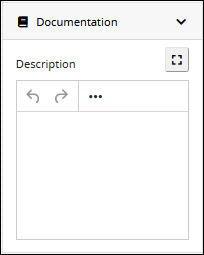
In the Description setting, edit the information to display when viewing documentation for this object and then press Enter. Alternatively, use the What-You-See-Is-What-You-Get (WYSIWYG) rich text editor to stylize your text by clicking the More icon
 .
. 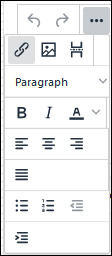
Follow these guidelines to use the WYSIWYG rich text editor to stylize your text:
Undo changes: Click on the
 icon to undo the last action.
icon to undo the last action.Redo changes: Click on the
 icon to redo the last undone action.
icon to redo the last undone action.Insert/Edit Link: Click on the
 icon to convert the selected text into a hyperlink. Follow these steps to create a hyperlink:
icon to convert the selected text into a hyperlink. Follow these steps to create a hyperlink: Select the required text from the Rich Text control.
Click on the
 icon. The Insert/Edit Link screen displays.
icon. The Insert/Edit Link screen displays. 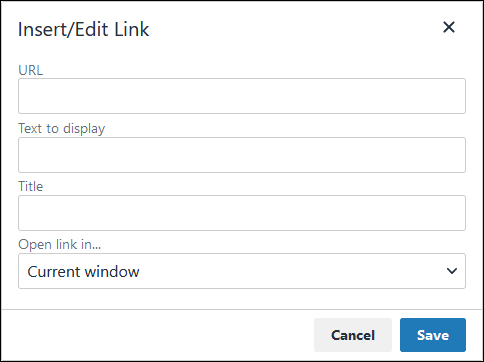
In the URL setting, enter the destination URL.
In the Text to display setting, edit or enter the text displayed in the Rich Text control.
In the Title setting, enter the text to display when a user hovers over the displayed text.
From Open link in… drop-down menu, select one of these options:
New window: Select this option to open the destination page in a new browser window.
Current window: Select this option to open the destination page in the current browser window.
Insert/Edit Image: Click on the Insert/Edit Image icon
 to insert an image. Follow these guidelines:
to insert an image. Follow these guidelines: Click on the Insert/Edit Image icon
 .
. The Insert/Edit Image screen displays:
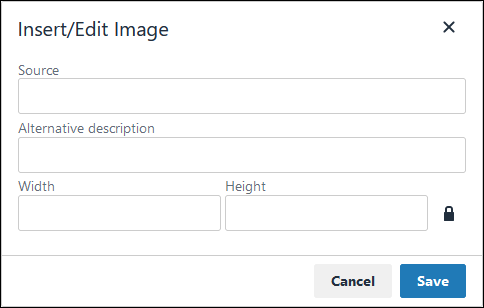
In the Source setting, enter a URL for the image.
In the Alternative Description setting, enter the text to display if the source URL of the image is not accessible.
In the Width setting, enter the maximum width for the image.
In the Height setting, enter the maximum height for the image.
Toggle the Constrain Proportions icon
 to maintain the width-height ratio of the image to its original proportion.
to maintain the width-height ratio of the image to its original proportion. Click Save.
Insert Page Break for PDF: Click on the Insert Page Break for PDF icon
 to insert a page break when a PDF document is created for this documentation if your browser supports this feature.
to insert a page break when a PDF document is created for this documentation if your browser supports this feature. Format text: Follow these guidelines to format text:
Headings: From the Paragraph/Formats menu, select Headings and then select a heading size.
Bold: Do one of the following:
From the editor toolbar, select the
 icon.
icon.From the Paragraph/Formats menu, select Inline and then Bold.
Italics: Do one of the following:
From the editor toolbar, select the
 icon.
icon.From the Paragraph/Formats menu, select Inline and then Italic.
Underline: From the Paragraph/Formats menu, select Inline and then Underline.
Strikethrough: From the Paragraph/Formats menu, select Inline and then Strikethrough.
Superscript: From the Paragraph/ Formats menu, select Inline and then Superscript.
Subscript: From the Paragraph/Formats menu, select Inline and then Subscript.
Code: From the Paragraph/Formats menu, select Inline and then Code.
Paragraph: From the Paragraph/Formats menu, select Blocks and then Paragraph.
Blockquote: From the Paragraph/Formats menu, select Blocks and then Blockquote.
Division: From the Paragraph/Formats menu, select Blocks and then Div.
Preformatted: From the Paragraph/Formats menu, select Blocks and then Pre.
Change text color: Use the Text Color drop-down to change text color. Click on the
 icon. The color palette displays. Do one of the following:
icon. The color palette displays. Do one of the following:Select one of the color swatches from the color palette. The selected text changes to that color.
Click the
 icon to select a custom color from the Color Picker.
icon to select a custom color from the Color Picker.Click the
 icon to reset the text to its default color.
icon to reset the text to its default color.
Align text: Follow these guidelines to align text:
Left align: Do one of the following:
From the editor toolbar, use the
 icon to left-align text.
icon to left-align text.From the Paragraph/Formats menu, select Align and then Left.
Center align: Do one of the following:
From the editor toolbar, use the
 icon to center-align text.
icon to center-align text.From the Paragraph/Formats menu, select Align and then Center.
Right align: Do one of the following:
From the editor toolbar, use the
 icon to right-align text.
icon to right-align text.From the Paragraph/Formats menu, select Align and then Right.
Justify: Do one of the following:
From the editor toolbar, use the
 icon to justify text.
icon to justify text. From the Paragraph/Formats menu, select Align and then Justify.
Insert a bullet list: Use the
 icon to format text as a bulleted list.
icon to format text as a bulleted list.Insert a numbered list: Use the
 icon to format text as a numbered list.
icon to format text as a numbered list.Indent text: Click on the
 icon to increase text indenting.
icon to increase text indenting.Outdent text: Click on the
 icon to decrease text indenting.
icon to decrease text indenting.
Assignment Rules Panel Settings
Select a task recipient and configure task re-assignment options.
Select the Task Assignee
Follow these steps to select the assignee for a task:
Select the Form Task object from the Process model.
Ensure that the Configuration panel displays. If not, show it. Panels to configure this object display.
Expand the Assignment Rules panel. The Assignment Type setting displays. The Request Starter option is the default setting.
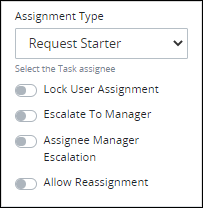
From the Assignment Type drop-down menu, select one of the following options:
Users / Groups: Select this option to assign the Task to a specified user or to a group member.
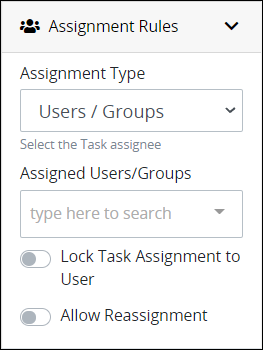
From the Assigned Users/Groups drop-down menu, select one or more users and/or groups for this Task. The Task is assigned following this protocol:
One user: The Task is assigned to the selected user.
One or more users and/or group(s): The Task is assigned randomly to one of those users or group members. The exception is if the Self Service toggle key is enabled, then the Task remains unassigned, in a queue, for one of those users to self-assign from the Self Service Task page.
Previous Task Assignee: Select this option to assign the Task to the assignee of the previous task.
Request Starter: Select this option to assign the Task to the Request starter. This is the default option.
Process Variable: Select this option to assign the Task determined by the value of a Request variable. The entered variable(s) may be one or both of the following:
Variable Name (Users): In this setting, enter the Request variable that contains the user ID(s) for one or more users. If more than one user ID is included the Request variable's value, then the Task is assigned randomly to one of those users. The exception is if the Self Service toggle key is enabled, then the Task remains unassigned, in a queue, for one of those users to self-assign from the Self Service Task page.
Variable Name (Groups): In this setting, enter the Request variable that contains a group ID(s). The Task is assigned randomly to one of the group members. The exception is if the Self Service toggle key is enabled, then the Task remains unassigned, in a queue, for one of those users to self-assign from the Self Service Task page.
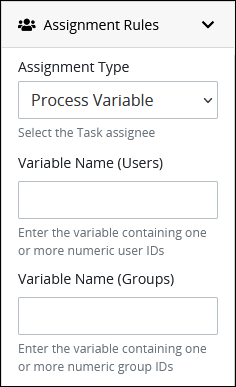
Rule Expression: Select this option to assign the Task's assignee using one or more rules. The rule expressions follow the Friendly Enough Expression Language (FEEL) syntax described in Expression Syntax Components.
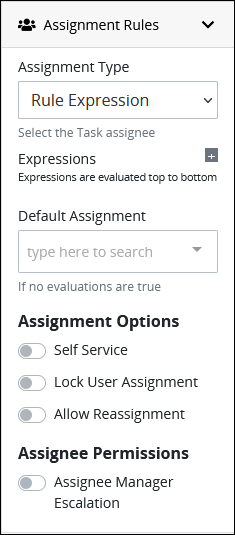
Each rule can only have one expression, but by using logical operators multiple conditions can be specified in that expression. You may use multiple rules to better confine the condition(s), and you may use Magic Variables in your expression. To add an expression, click the add
 button.
button. 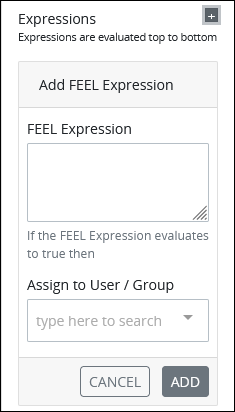
Follow these steps to define an expression:
In the FEEL Expression setting, enter or edit the expression using the syntax components described in Expression Syntax Components, and then press Enter.
From the Assign to User/Group drop-down menu, select the user or group to assign the Task to when the FEEL Expression evaluates to True.
From the Default Assignment drop-down menu, select a user or group to assign that Task to if none of the expressions evaluate as True.
Process Manager: Select Process Manager to assign the Task to the Process Manager. Ensure to configure the Process Manager for this Process.
Enable the Self Service toggle to allow group members to self-assign the Task from a queue. This option is only available if the Assignment Type is set to Users / Groups, Process Variable, or Rule Expression.
Enable the Assign to Manager toggle key to assign that Task to the manager of the task assignee. An Administrator can configure the manager for each user in their user account.
Enable the Lock User Assignment toggle to ensure the Task is reassigned to the same user if the workflow returns to it. This is useful when the original assignee may need to clarify or update information they previously submitted.
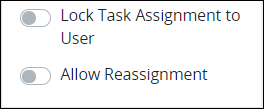
Enable the Allow Reassignment toggle key to allow the Task assignee to reassign the Task if necessary. If the Allow Reassignment option is enabled, the Reassign button displays in the Task summary to allow for task reassignmen. For more information, see View a Task Summary.
Enable the Allow Manager Escalation toggle key to automatically reassign this Task to the Task assignee's manager. An Administrator can configure the manager for each user in their user account.
If you enable the Allow Reassignment option, make sure the Task is assigned to multiple users or to a group. Otherwise, even though the Reassign button will appear in the Task summary, the assignee will have no available users to reassign the Task to.
If this Form Task object is configured to assign the Task to an anonymous person who started this Request via Web Entry, the settings described here are disabled because these Form Task object settings only configure which authenticated user(s) may assigned this Task. Therefore, to configure these settings, either disable Web Entry or select that authenticated users may start Requests from this object via Web Entry. See Web Entry Panel Settings.
Notifications Panel Settings
Configure when to send task notifications. Task notifications are shown in ProcessMaker Platform and can be accessed using the Notifications .png) icon on the top right the screen. Task notifications can be sent to the following users:
icon on the top right the screen. Task notifications can be sent to the following users:
Requester: This is the user who started the process.
Task assignee: This is the user to whom the task is currently assigned.
Request participants: All users you have participated in the process.
Process Manager: The user set as the Process Manager in process configuration.
A copy of these notifications is also sent as automated emails to users. To disable these emails, see User Profile Settings.
To setup custom email notifications, see email notifications for Tasks.
Set Task Notifications
Task notifications can be sent to participants when following events occur.
Task Notifications | |
|---|---|
Assigned | Send a notification when this task is assigned or reassigned. |
Completed | Send a notification when this task is completed |
Due | Send a notification when this task is due. |
Follow these steps to set Task notifications in a Form Task object:
Expand the Notifications panel.
.png)
From the Requester settings, set Task notifications for the Requester.
From the Assignee settings, set Task notifications for the assignee of the current task. The Assigned and Due notifications are enabled by default for task assignees.
From the Participant settings, set Task notifications for all process participants.
From the Process Manager settings, set Task notifications for the Process Manager.
Email Notifications Panel Settings
Configure when to send email notifications to task recipients. Email notifications can be sent to the following recipients:
Users and/or group members. Note: Members of a child group within a parent group will not receive email notifications unless the child group is selected in the email notification configuration.
Specific email addresses for individuals who are not users in your ProcessMaker Platform instance.
The email body for the Task notification may be plain text or an Email-type Screen. Email notifications are sent to recipients based on the following events:
Task trigger: Send email notifications when a Task is activated.
Task completion: Send email notifications when a Task is completed.
Value in Request data or Magic Variable: Specify an expression to conditionally send the email notification when a Request Variable or Magic Variable meets a specific setting or condition. Specify this condition using an expression syntax described in Expression Syntax Components.
Set Recipients for This Email Notification
Use the To, Cc, and Bcc settings to set which users, groups, and/or email addresses to send this email notification.
Follow these steps to set the recipient(s) for this email notification:
Select the Form Task object from the Process model.
Click the Show Configuration button
 in the upper right of the Process Modeler canvas.
in the upper right of the Process Modeler canvas.Expand the Email Notifications panel if it is not presently expanded. The Notifications setting displays.
Click the
 icon to add an email notification.
icon to add an email notification.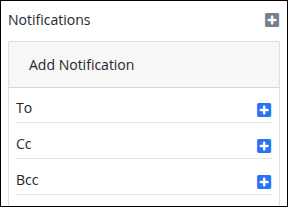
From the To, Cc, or Bcc settings, click the
 icon to display the Add a Recipient window.
icon to display the Add a Recipient window.From the Recipient Type dropdown, select the recipient(s) of this email:
Users and Groups: Send this email to user(s) or group(s). When this option is selected, the Users and Groups setting displays. Select a user or group from the available list.
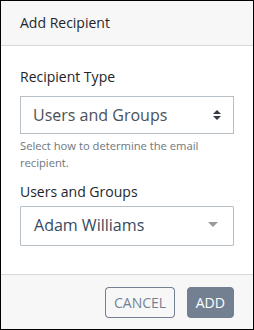
Request Starter: Send this email to the user who started this Request.
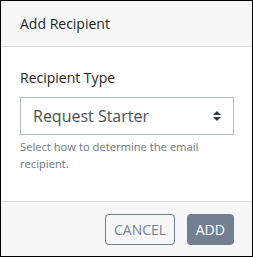
Participants: Send this email to all users participating in this Request.
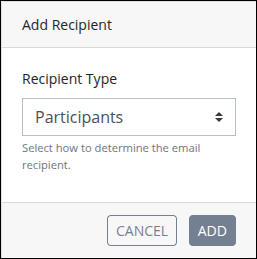
Assigned User: Send this email to the user currently assigned to the task.
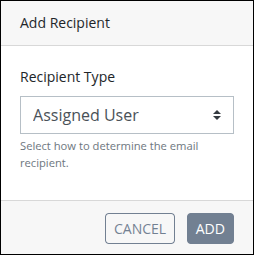
User ID: Send this email to a user based on the value of a Request variable. When this option is selected, the User ID setting displays. Enter a variable name in this setting. A valid user name must be assigned to this variable in a previous step in the Request.
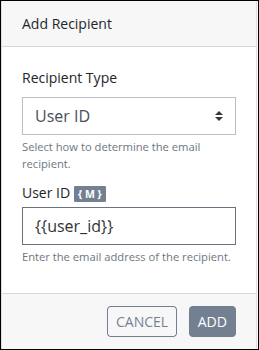
Email Address: Send this email to the entered email address. When this option is selected, the Send to Email Address setting displays. Enter a single email address or multiple email addresses separated by commas with no spaces.
For example:
amanda@mycompany.com,john@homeoffice.com.Alternatively, enter a Request variable in mustache syntax that contains a comma delimited string of multiple email addresses.
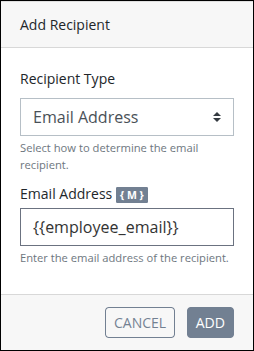
Process Manager: Send this email to the Process Manager assigned in the Process's configuration.
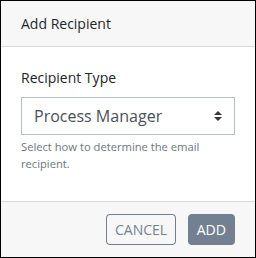
Click Add to list the recipients.
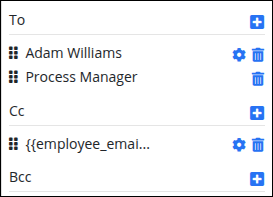
Click the
 icon to edit an email recipient that is currently added.
icon to edit an email recipient that is currently added.Click the
 icon to remove an email recipient that is currently added.
icon to remove an email recipient that is currently added.
Set the Email Server
From the Email Server drop-down menu, select an email server. The Default Email Server option is the default. If additional email servers are configured in Admin Settings, they will be displayed in the Email Server drop-down menu.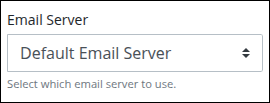
Set the Email Notification's Subject and Body Content
Email Notifications settings in Form Task objects are not included when importing a Process. Configure Email Notifications settings after importing the Process instead.
Follow these steps to configure email notification settings:
From the Subject setting, revise the default text if necessary that displays as the email subject. By default, ProcessMaker Platform displays the current Form Task object's Name as part of the Subject.

From the Body setting, select one of the following options:
Plain Text:
Select the Plain Text option to enter plain text to display as the email body. This is the default option. Follow these steps:
From the Body setting, ensure that the Plain Text option is selected.
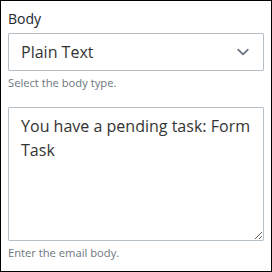
In the setting below the Plain Text option, revise the default text if necessary.
Display Screen:
Select the Display Screen option to select an Email-type Screen to use as the email body. Follow these steps:
From the Body setting, ensure that the Display Screen option is selected.
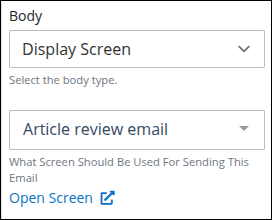
From the drop-down menu below the Display Screen option, select a screen from the list. Only Email-type Screens display from this drop-down menu.
Optionally, click the Open Screen link to view and/or edit your selected Screen. Note: You must have appropriate Screen category permissions to view and/or edit the selected Screen.
Select Files to Attach to This Email Notification
Use the Attach File setting to specify one or more file(s) to attach with this email notification. Follow these steps:
Click the +File button to specify the files to attach to this email notification.
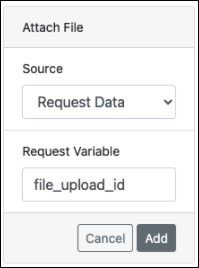
From the Source setting, select one of the following options:
URL: Select the URL option to provide a link to the file to be attached. Follow these guidelines:
In the URL setting, enter the URL referencing an attached file to be accessed from a Web address.
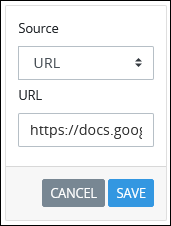
Click Save. The URL referencing the file displays.
Request Variable: Select the Request Variable option if the file to be attached can be referenced through a request variable. Follow these guidelines:
In the Request Variable Name setting, enter a Request variable name without the mustache syntax. This variable must already be linked to a File Upload control in a Screen in the same Request. When the Request is in-progress, any file uploaded using this File Upload control is attached to this email notification. This is a required setting.

Click Save. The Request variable referencing the file displays.
Request Array: Select the Request Array option to attach multiple files. Follow these guidelines:
In the Request Array Variable Name setting, enter an array-type Request variable. This variable must already be linked to a File Upload control with Upload Multiple Files option enabled in the same Request. When the Request is in-progress, any files uploaded using this File Upload control are attached to this email.
In the Variable in Array setting, optionally enter the name of a variable in the Request Array Variable containing ID of the file to be attached. If the Request Array Variable is a simple array containing a list of files, leave this setting blank.
Click Save. The Request variable referencing the files displays.
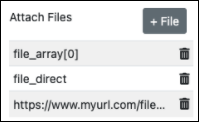
Repeat steps 3 and 4 to add additional files.
Optionally, click on the Delete
 icon to delete any referenced file from being attached to the email.
icon to delete any referenced file from being attached to the email.
Set When This Email Notification Sends
Use the Send At or Expression settings to set when this email notification is sent. Do one of the following based on when you need the email notification sent:
From the Send At setting, select one of the following options:
Task Start: Select the Task Start option to send this email notification when this Form Task is activated. This is the default option.
Task Completion: Select the Task Completion option to send this email notification when this Form Task completes (when the Task assignee submits the Screen associated with this Task).
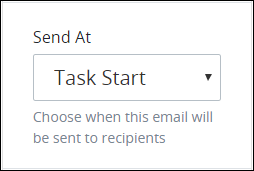
In the Expression setting, optionally enter the expression to conditionally send the email notification when a Request data object or Magic Variable meets a specific setting or condition, and then press Enter. Specify this condition using an expression syntax described in Expression Syntax Components. Use logical operators to specify multiple conditions in that expression if necessary. If the Expression setting does not contain a value, then the Send At setting determines when to send email notifications for this Task.

Click Close. This email notification is saved and displays below the Notifications setting using the Subject setting as the email notification label.
Click the Edit icon
 beside the email notification to edit.
beside the email notification to edit.Click the Duplicate icon
 beside the email notification to duplicate it.
beside the email notification to duplicate it. Click the Delete icon
 beside the email notification to delete. The following message displays to confirm deletion of this email notification: Are you sure you want to delete this notification?
beside the email notification to delete. The following message displays to confirm deletion of this email notification: Are you sure you want to delete this notification?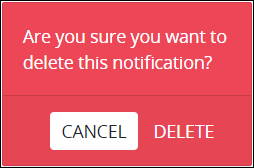
Click Delete.
Consider carefully when deleting an email notification. Deleting a configured email notification cannot be undone.
Default Email Notification for New Form Tasks
When a new Form Task is created, the platform automatically generates a default email notification to streamline case communication. This built-in configuration includes the following pre-filled values:
Recipient:
Assigned UserEmail Server:
Default Email Server(configured in Admin > Email Settings)Subject:
RE: {{_user.firstname}} assigned you in "{{_task_name}}"Body: Uses the Default Email Task Notification display-screen
Send At:
Task Start(immediately when the task is assigned)
This auto-generated configuration ensures that assigned users receive timely notifications without requiring manual setup. You can customize or disable the notification as needed by editing the Form Task’s Email Notifications panel settings.
Actions By Email
Allow task recipients to complete tasks directly from their email inbox without logging into the ProcessMaker Platform. When a task is assigned, the user will receive an email notification through which they can take action on the task.
Forwarded Emails
If an Actions by Email notification is forwarded to another user, that user can still complete the action, and the system will treat it as if it came from the original assignee. Therefore, use caution when forwarding these emails, as this may allow unauthorized Task actions.
View an example of how to enable Actions by Emails for a task.
Steps to enable Actions by Email
Follow these steps to enable Actions By Email for task recipients:
Select the Form Task from the Process model.
Click the Show Configuration button
 in the upper right corner of the Modeler.
in the upper right corner of the Modeler.Expand the Email Notifications panel. The Actions By Email toggle displays below the Notifications setting.
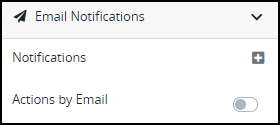
Enable the Actions By Email toggle to display settings for it.
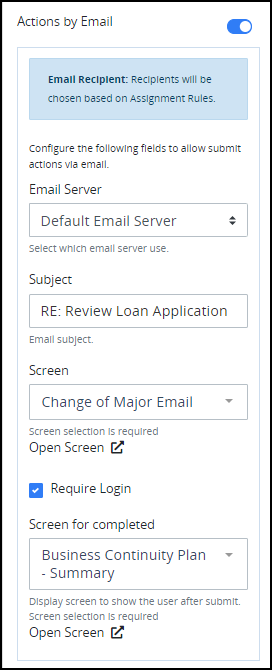
From the Email Server drop-down menu, select an email server. The Default Email Server option is the default. If additional email servers are configured in Admin Settings, they will be displayed in the Email Server drop-down menu.
In the Subject setting, enter the subject of the email. For example, enter the decision that the email recipient must take through this email.
From the Screen drop-down menu, select an email-screen. When an email notification is sent, this screen will be displayed to the participant through which they can take an action on the task.
Ensure that this screen uses Submit button controls to allow users to take an action on task. The Link URL control can also be used to take the user to an alternate form for task completion.
Enable the Require Login setting to require a user to log in before filling out the screen.
From the Screen for Completed drop-down menu, select a completion screen to indicate to the user that the task was successfully submitted.
Web Entry Panel Settings
Web Entry provides a seamless and straightforward method for initiating or completing cases, catering to both anonymous and authenticated users. This feature allows external users to start and work on cases through a link without the need to access the ProcessMaker Platform dashboard.
Configure Web Entry for a Task
Follow these steps to select to configure web entry for a task:
Select the Form Task object from the Process model.
Ensure that the Configuration panel displays. If not, show it. Panels to configure this object display.
Expand the Web Entry panel if it is not presently expanded. The Mode setting displays.
From the Mode drop-down menu, select one of the following options.
Disabled
Select the Disabled option to disable Web Entry for this task and allow access through ProcessMaker Platform only. This is the default setting.
.png)
Anonymous
Select the Anonymous option to allow the task to be accessed without having to log in to ProcessMaker.
.png)
If selecting the Anonymous option, consider using the following settings:
Select Require Valid Session to require users to log in to the ProcessMaker Platform to access the task. Even though users will log in, the task will be submitted anonymously.
From the Completed Action drop-down menu, select one of the following options:
Screen: Select the Screen option to display a screen after the Task assignee submits the Task.
From the Screen For Completed drop-down menu, select the Screen. This drop-down menu displays only Display types to display a message to the request starter. This is a required setting.
Optionally, click the Open Screen link to view the selected Screen in a separate Web browser window, or create a new screen using the +Create a New Screen link.
Select the Enable Password Protect setting to require a password to access the Web Entry.
URL: Select the URL option to indicate that the Task assignee is redirected to a URL after the Task is completed.
In the Redirect URL setting, enter the URL and then press Enter. The redirect URL supports mustache syntax to reference the value of a Request variable as the URL. This is a required setting.
Select the Enable Password Protect setting to require a password to access the Web Entry URL.
Authenticated
Select the Authenticated option to assign the Task to an authenticated user or group member. If an authenticated user or group member is already selected from the Assignment Rules panel, then only one of those user(s) may view this task.
.png) If selecting the Authenticated option, consider using the following settings:
If selecting the Authenticated option, consider using the following settings:
From the Completed Action drop-down menu, select one of the following options:
Screen: Select the Screen option to display a screen after the Task assignee submits the Task.
From the Screen For Completed drop-down menu, select the Screen. This drop-down menu displays only Display types to display a message to the request starter. This is a required setting.
Optionally, click the Open Screen link to open the selected Screen in a separate Web browser window, or create a new screen using the +Create a New Screen link.
URL: Select the URL option to indicate that the Task assignee is redirected to a URL after the Task is completed.
In the Redirect URL setting, enter the URL and then press Enter. The redirect URL supports mustache syntax to reference the value of a Request variable as the URL. This is a required setting.
Exclude Data and Copy URL
Follow these steps to prevent sensitive data being accessed in the web entry and learn how to share the web entry URL.
From the Exclude Data setting, optionally exclude any Request data from being included in the Web Entry Task so that it does not display in the Screen for that Task. Specify the Request variable name to exclude as indicated by the Screen control's Variable Name setting value.
Click the
 icon to add a variable.
icon to add a variable.Enter the Request variable name into the setting.
If necessary, click the
 icon to remove a variable.
icon to remove a variable.The Web Entry URL displays the URL to use for viewing the form associated with this task. The Web Entry URL value cannot be changed. ProcessMaker Platform generates this URL using the following structure:
ProcessMaker Platform instance domain/webentry/Web Entry numerical instance/Identifier Value of this Form Task object.Click the Copy button below the Web Entry URL setting to copy the Web Entry URL so that it is available in your clipboard.
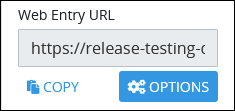
If you are copying an anonymous Web Entry link while logged in to ProcessMaker, the following message will be displayed. This message indicates that you must log out in order to use this Web Entry link.

Users accessing an authenticated Web Entry task via a direct URL see an Unauthorized message if they are not assigned to the task. The message reads:
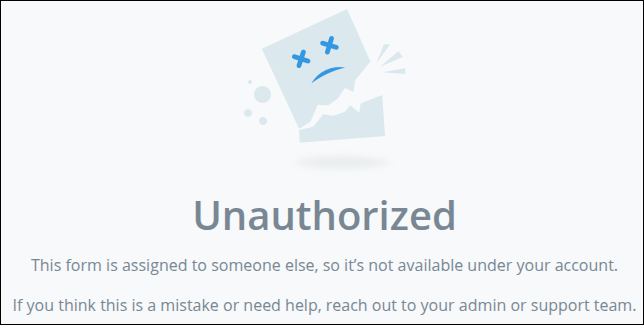
📝 Superadmin users can still access the task normally from within the Requests or Cases view. This restriction only applies when attempting to access the task via direct Web Entry URLs without being assigned.
The Embed Code setting displays the JavaScript that contains the Web Entry URL to embed into your Web server's or blog's HTML header. If necessary, click the Copy button below the Embed Code setting to copy the Web Entry URL so that it is available in your clipboard.
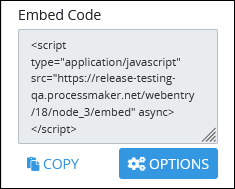
If this Form Task object's Web Entry uses a Conversational-type Screen to provide a chat-style interaction with the Request starter, optionally click the Options button below the Embed Code setting to configure how the chat box displays in the embedded container to which the Web Entry's JavaScript code is applied. When the Options button is clicked, the Embed Options screen displays.

Configure how the chat box displays in the embedded container from the following options:
From the Position setting, select one of the following options:
Fill Container: The chat box displays the width of the container to which the Web Entry's JavaScript code is applied. This is the default setting. When the Fill Container setting is selected, all other settings in the Embed Options screen are disabled.
Top Left: The chat box displays in the top left corner of the container to which the Web Entry's JavaScript code was applied.
Top Right: The chat box displays in the top right corner of the container to which the Web Entry's JavaScript code was applied.
Bottom Left: The chat box displays in the bottom left corner of the container to which the Web Entry's JavaScript code was applied.
Bottom Right: The chat box displays in the bottom right corner of the container to which the Web Entry's JavaScript code was applied.
In the Title setting, enter the title that displays in the chat box. Form is the default setting. This setting does not apply when the Fill Container option is selected from the Position setting.
From the Color setting, select the color that displays for button to show the chat box and for the chat box frame itself. The left-most color option is the default. This setting does not apply when the Fill Container option is selected from the Position setting.
From the Icon setting, select an icon that displays to show the chat box. The Question Circle is the default option. This setting does not apply when the Fill Container option is selected from the Position setting.
Click Save.
Considerations for Using Web Entry
Parallel Tasks: When designing a process, parallel tasks connected through a parallel gateway do not support the use of Web Entries.
Request Summary: The Screen used for Web Entry does not display in the Forms tab in Request summary.
Multi-instance (parallel) Loops: Web Entry settings are not supported for tasks configured with Multi-instance (Parallel) Loops.
Embedding Rules: Due to the default Laravel cookies, Web Entries cannot be embedded into a third-party site for authenticated users.
Testing Web Entries: When testing an anonymous Web Entry during process design, always test or open the Web Entry link in a private (incognito) window.
Vocabularies Panel Settings
Vocabularies validate that Request data complies with a specific JSON schema. This is often mandatory for many types of business sectors including banking and healthcare ensuring the quality and compliance of Request data. For example, during a Loan Application process, ensure that all required personal information has been included in the Request.
Use a Vocabulary on a Form Task to validate that Request data complies with the Vocabulary's JSON schema after the Task assignee submits the Task. Multiple Vocabularies can be assigned to a Form Task object. During an in-progress Request, if the Request data no longer complies with all assigned Vocabularies, the Request status changes from In Progress to Error in the Request summary. Vocabularies are cumulative in an in-progress Request: as the Request progresses, if Request data does not conform with any Vocabulary's JSON schema, the request status displays an error. For more information What is a Vocabulary? and Create a New Vocabulary.
Assign Vocabularies That Validate Request Data
Follow these steps to assign Vocabularies that validate Request data from a Form Task object:
Select the Form Task object from the Process model in which to assign Vocabularies that validate Request data prior to when this object completes.
Ensure that the Configuration panel displays. If not, show it. Panels to configure this object display.
Expand the Vocabularies panel if it is not presently expanded. The Assigned setting displays.

Click the
 icon to add a Vocabulary. The Assign Vocabulary option displays.
icon to add a Vocabulary. The Assign Vocabulary option displays. 
From the Select Vocabulary drop-down menu, select a Vocabulary from which to validate Request data complies with its JSON schema.
If no Vocabularies are configured in your ProcessMaker Platform instance, then the following message displays: List is empty. Create at least one Vocabulary. See Create a New Vocabulary.
Click Save.
Repeat Steps 3 through 5 as necessary for each Vocabulary required to validate Request data complies with its JSON schema.
Click the Remove icon
from the Vocabularies setting to remove a Vocabulary from assignment to this object.
After one or more Vocabularies are assigned to a Form Task object, the Vocabulary icon displays in that object.

Form Task object with an assigned Vocabulary
Advanced Panel Settings
Edit the Node's Identifier Value
Process Modeler automatically assigns a unique value to each Process node added to a Process model. However, a node's identifier value can be changed if it is unique to all other nodes in the Process model, including the Process model's identifier value.
All identifier values for all nodes in the Process model must be unique.
Follow these steps to edit the identifier value for a Form Task object:
Select the Form Task object from the Process model in which to edit its identifier value.
Ensure that the Configuration panel displays. If not, show it. Panels to configure this object display.
Expand the Advanced panel if it is not presently expanded. The Node Identifier setting displays. This is a required setting.

In the Node Identifier setting, edit the Form Task object's identifier to a unique value from all nodes in the Process model and then press Enter.
.png)
.png)